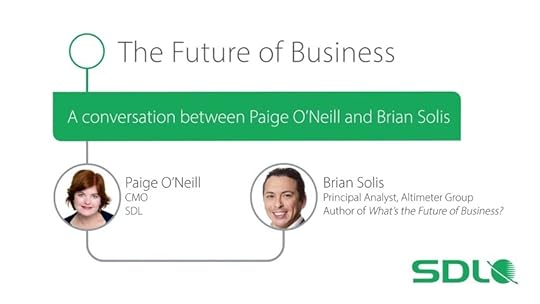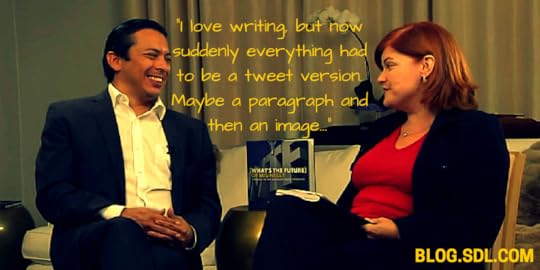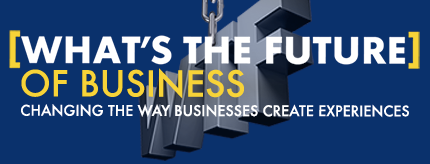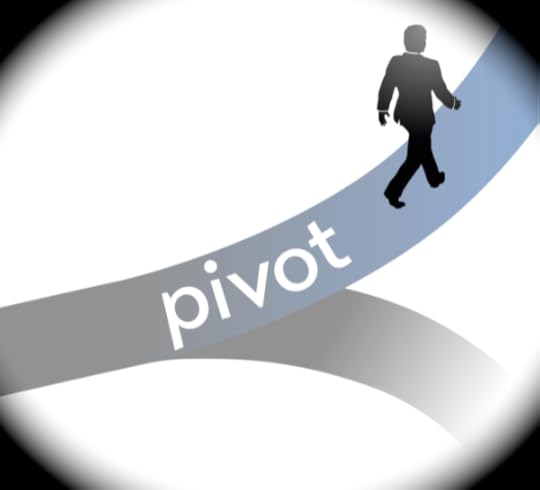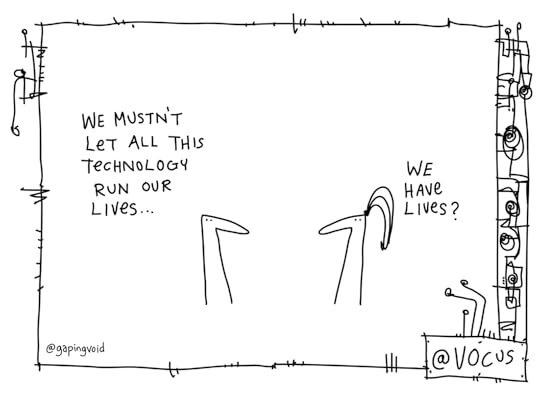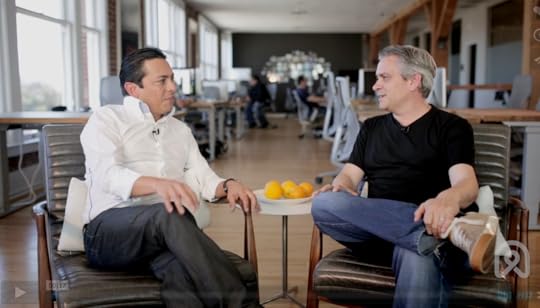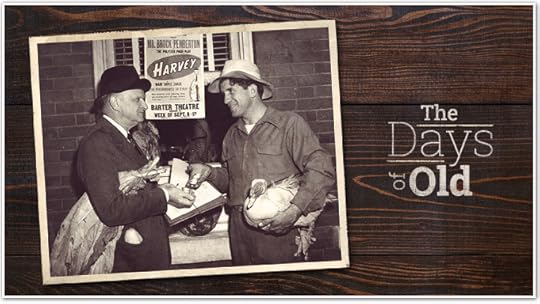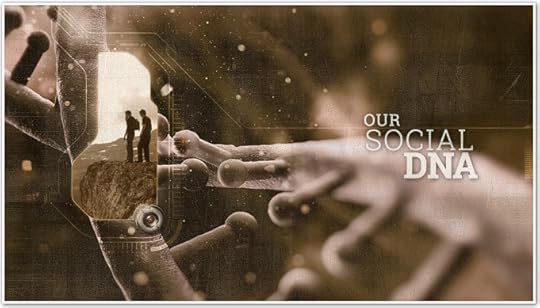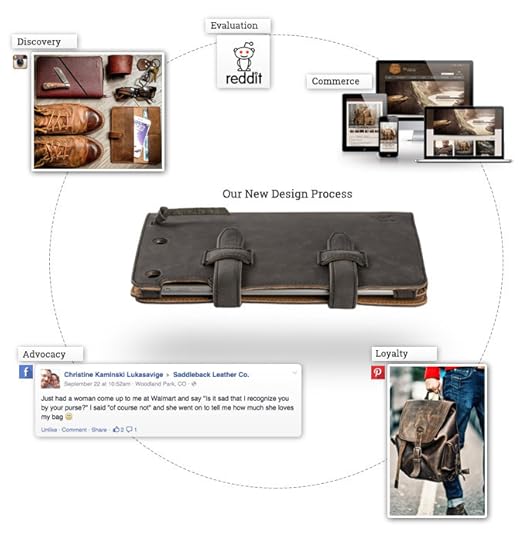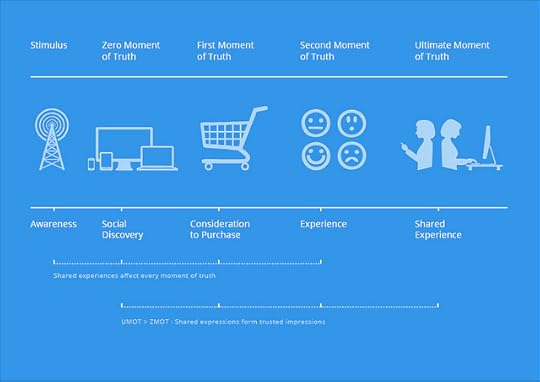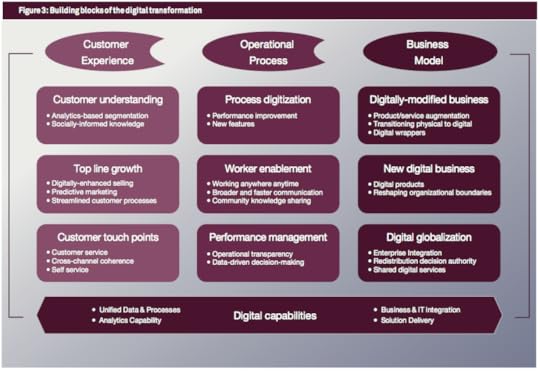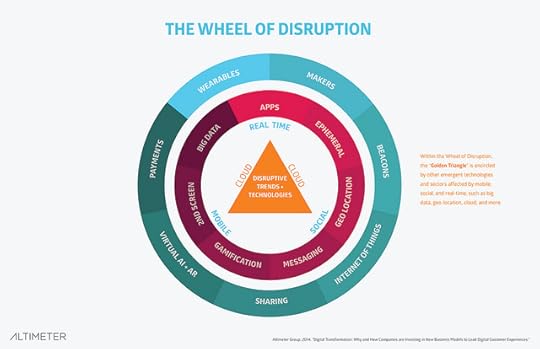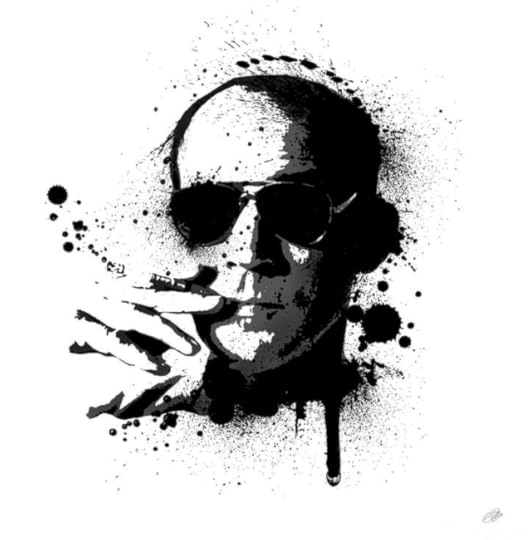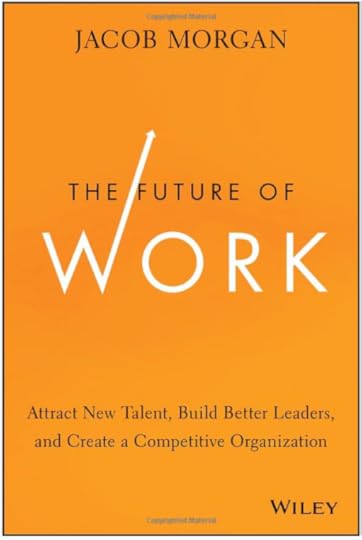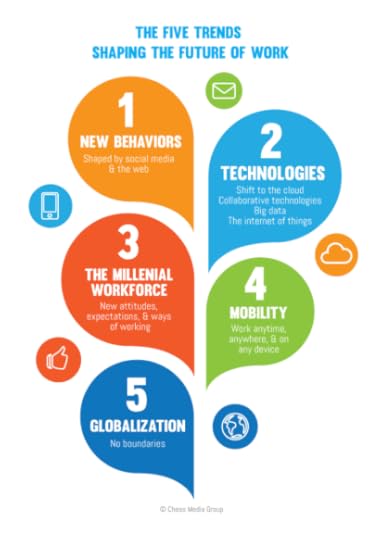Brian Solis's Blog, page 108
October 17, 2014
The Future of Business Starts with Us
I often share a quote by Russian novelist Leo Tolstoy, “Everyone thinks of changing the world, but no one thinks of changing himself.”
And that’s where are in business. We all talk of change but very few of us start with changing the very things that will help us more effectively compete for the future.
It’s changing or it should change…
What we see (perspective and vision)
What we create (product)
What we do (work)
Why we do it (purpose)
How we do it (process)
Who we do it with (people)
How we define success (objectives and metrics)
What we do next (planning and strategy)
We are change.
What’s important to remember is that the future of business has been widely speculated but not documented. This means that the future is being written as we go by what we say and do and also by what we do not say and do.
I spent time with SDL CMO Paige O’Neill to discuss our role in the future of business and what possibilities will unfold when we put people first in this digital era. The resulting video is something that I wanted to share with you here.
In our fireside style discussion, we explore the rise of Generation C, market disruption and the role of empathy in your business strategy. It’s very conversational and fun while still tackling tough subjects.
Other important topics include:
Customer experience (CX) is becoming more important than the product itself.
Disruptive technologies and customer behavior are changing how we do business.
‘Generation C’ – looking at the customer, not by age but how they behave and become digitally connected.
Digital experience and the journey.
The importance of empathy combined with understanding the customer.
Please take a moment to watch the video now. (Note: Email gated)
Connect with me…
Twitter | LinkedIn | Facebook | Google+ |Youtube | Instagram | Pinterest

October 13, 2014
Pivot: The Emergence of Digital Compels Businesses to Transform
Guest post by Mike Edelhart, c0-producer and CEO of the Pivot Conference
Historic shifts in business fundamentals don’t occur smoothly; rather they happen in sudden, sharp shifts which open unexpected chasms companies must traverse or plunge.
Today, the deep change in human behavior brought about by the emergence of social media marks the latest such shift, perhaps the most dramatic since the Industrial Revolution. Gone are the traditional success factors of operational efficiency and price advantage being uprooted by the conversational, consumer-centric nature of the emerging business environment. Already, quick response, collaboration and flexibility are trumping traditional competitive advantages. And this shift seems to be accelerating into an ever-more-social future.
”Digital transformation is causing a tectonic shift in how companies are structured and led, and how they perform and compete…Digitization is increasing the pace of change throughout the economy, even in sleepy mainstream industries” notes Pierre-Yves Cros, Chief Development Officer of international consulting firm CapGemini. “These shifts are broad and deep and they’re just getting under way… No firm is immune from digital transformation.”
A study by CapGemini and MIT’s Center for Digital Business found that companies that have already responded most deeply to social challenges are 26% more profitable than laggards. Two measures separated those winning companies from others: Digital Intensity, the penetration of social, mobile and other emerging technologies deeply into customer engagement and business operations. Transformative Management Intensity, where a clear vision of how digital is changing the company expresses itself as alterations in governance, customer management and IT-business relationships.
Moving from rhetoric to reality in response to digital transformation is anything but straightforward. Current corporations have hired, trained and compensated a generation of employees around incremental operational improvements. They have, in short, an army optimized to fight the old war, as a new war roars upon them. This new war demands effective, quick response to whatever social/mobile data reveals and collaboration with a diasporic customer and influence population, all in a word where ownership of the prime relationship stands to overpower any other advantage.
A recent massive study by the Harvard Business School Forum on Innovation indicated that, in the end, only two variables may matter. This rigorous analysis of what separates successful companies from others uncovered these two rules: Better before cheaper—companies that compete on differentiators other than price win. Revenue before cost—companies that prioritize increasing revenue over reducing costs prosper more highly than others. How important are these two variable to success? The report concludes: “There are no other rules…. so change anything you must to follow Rules 1 and 2.”
So, the keys to digital transformation may come down to how companies can use social data to make their products “better” in the eyes of empowered consumers and so find new sources of revenue.
We also don’t need to look much further than my co-producer and someone with whom you already know very well. Brian Solis also published research on the state of digital transformation and found, in his two reports this year alone, that companies are undergoing change to compete in a digital economy but most don’t know why. In his most recent study, Solis found that 88% of digital strategists and executives claimed that the digital customer experience was driving digital transformation efforts yet only 12% launched efforts to understand the digital customer journey.
Wow. Just wow.
Companies won’t fail in response to digital change because they don’t see it coming; they will fail because their organizations aren’t set up to respond in ways that can really save them. “Big companies are really bad at innovation,” says Harvard’s Maxwell Wessel. “Because they’re designed to be bad at innovation.”
Pivot Conference talks place October 16-17 at the NASDAQ Marketsite in Times Square NYC. Pivot is an invitation-only event for senior executives who lead social, mobile and business transformation initiatives for major corporations. Requests for invitation should be directed to: Matt Godson, matt@momentumevents.com

October 7, 2014
Pivot: The Total Digital Experience
Pivot Conference in NYC in October is unique among events in that, each year, it shifts focus to deeply reflect the needs of its community of senior business transformation executives from leading brands and organizations. To make that happen, I serve as Pivot’s Executive Producer along with Pivot CEO, Mike Edelhart.
For four years in a row, we’ve put our heads together to develop a story arc that covers the hottest, emergent trends, presented by the industry’s most engaging experts over the span of two days. They bring to life my work in digital transformation and the digital customer experience and Mike’s perspective as lead partner for the Social Starts investment fund.
To celebrate the upcoming event next week, Mike and I got together to talk about the story behind this year’s Pivot.
Mike – This is Mike Edelhart, the CEO of The Tomorrow Project, the producers of the Pivot Conference in New York, and I’m here with Brian Solis, executive producer of Pivot, author, partner of the Altimeter Group, and friend. Hey Brian!
Brian- Hey Mike, I can’t believe we are back at it again – it seems like yesterday we did the last Pivot Conference.
Mike- I know, we’ve been at this now four times, I guess, and each time, at least in my experience (and I expect in yours) it’s been a little different – and we do that on purpose – so maybe that’s a good way to start. From your point of view, what do you think has made Pivot unique and what do you think makes it particularly unique this year?
Brian- You know, the thing that I love about Pivot is it first starts with working with you, working as friends, it becomes a real personable conference. We all go to these conferences to get smarter, to meet people and network. Then there are conferences like Pivot where you really start to feel a part of a community – part of a movement is probably a better way to describe it – and I think that’s what made Pivot really special for me and what keeps me coming back every year is that you can actually see progress in the themes and in the people we bring together and in the careers of those who advance who attend Pivot – we’re really pushing things forward and I feel a little proud to be a part of it.
Mike- Yes, same here. We’ve talked about this since the very beginning of Pivot – the senior executive community we serve, the world that’s being transformed by social and mobile technology, keeps changing and we need to change with it and at least for me, one of the things about this year that’s most exciting is the notion that we have a two day conference where each day is essentially a one-day event unto itself, trying to get our arms around the breadth of what’s happening out there for the companies we serve now. We’ve all decided that the first day is about business transformation.
What does business transformation mean for you? I know you’ve written about it. When we say to folks: “come to Pivot on the first day – we’re doing business transformation” – what does that mean for you?
Brian- There’s this way of doing business, the way that always been done – you look at the classics, the business models that we’ve been taught in school. But you have technology that has continued to evolve to the point where now the machine is an extension of the person. Everybody sort of jokes around that the next evolution of human beings is that everybody’s hands are going to be little bit longer so that they can accommodate texting and multitasking on one screen a lot more efficiently.
In all seriousness, transformation starts to look at people first, it’s going back to the basics of just who are the people that we want to do business with? And why would they want to do to business with us? Who are the people that we want to work with us to do a better job and how do they want to work? This is the transformation – a much more human approach when we say “wow- those processes, those systems, those reward-mechanisms, those policies that we have, I mean everything is open to change.
That’s what really inspires me.
Mike- I think that’s right. I’ve sometimes described it as the companies that we work with are being compelled to reconfigure and redecorate the house whilst still living in it and that’s a significant challenge. We know Pivot – we’ve been doing it for a while – we know the community that comes to Pivot but obviously not everybody does. So, if somebody is listening to this or reading about this conversation, what kind of executive do you think will get the most value out of what we are going to be doing on Day 1 of Pivot, which by the way is the 16th of October; Pivot is going to be 16th and 17th at the NASDAQ this year, which is a pretty cool venue.
Brian- I am really excited about that. I love the approach that we’re taking this year – we’ve always been a two day conference and it was always a lot for people to digest and, by breaking it up into two different groups, the first group I see really as the decision makers or the lead strategist. Anybody who really is looking for the vision and the inspiration to go back into their organization and lead from the top down – to bring the right people together to lead in new directions or to research new opportunities but to be able to do so with authority.
I am truly curious to see how well that day evolves or unfolds because we’ve put together, as you know, a really incredible program for Day 1 because we really want to show those executives and decision makers what’s changing, how it’s changing, why it’s changing and then give people the full rounded story and the details necessary – but at a high level – so that they’re going to go back with “we are going to do this, or we need to know this and this and this” – and that’s pretty interesting to me.
Mike- I agree and we’ve talked a bit here about the fact we have two days and two different areas of focus, so we should probably talk about the second day as well which is going to be focused on where things stands now for big companies struggling to stay ahead of change related to marketing and influencing communication, and it gets me thinking back to that very first Pivot where all we cared about was Millennials – “the kids won’t behave” – well, actually everybody is behaving differently; The rise of the social consumer in the second Pivot and then the question of social brand and social business in the third Pivot. So, it leads to the natural question: What do you think the current state of social marketing is now? When we talk about social marketing at Pivot, where do you think we will be focusing our attention?
Brian- Well, I hope to be focusing our attention on areas that really show the breadth of social impact because what it really does come down to, in my view, is that social has democratized information, democratized audiences, networks, markets and that’s only becoming more profound as every day passes. So, when we talk about social, what we’re talking about is this great equalizer and how do we look at everybody who is not behaving the way you think they’re behaving.
One of the things that still surprises me, for example, is when a company says, “ok, the customers are different and technology is different, so what are we going to do? Let’s map the customer journey so that we know where to make investments and prioritize those on a road map”. Yet they’re still making the same assumptions they’ve always made about their customers. When we talk about social, it is exactly that – becoming part of the community, understanding your customer or your employee or your influencer or your detractor and where those touch points are. How do you use them for advances?
So that you can become part of those communities and redefine what the journey is. Not what you think it is but what it should be and then make the investment not just in technology and road maps but also in processes. How should things be different?
Do I really have to go through six different screens to be able to make a decision or a purchase because your process doesn’t work on the back end? There is one company that I was working with that said “our best customers get the worst experience” and by that they meant that they had so many different product lines but none of those product lines act as one company – every product has its own company and none of those systems talked to one another.
The whole idea of social, to me at least, and what I hope people will take away from that is to recognize that, in order to become relevant in any market or any community, you have to become part of it and that’s a philosophical switch as much as it’s a business and a technology investment.
Mike- I agree completely. It’s all in the end about human beings and the fact that we can now see through analytics and emerging capabilities, the complexity that the variety of human experience make. So across this big arc of experience we are going to have at Pivot this year, I’m curious as to what part of the program are you most looking forward to being part of?
Brian- There is a one part that I am really looking at and is that around the sharing aspect of the economy and how this is gathering a lot of momentum. The taxi medallion, for example, was always considered one of the best investments and there was a real interesting piece done out of Chicago that shows how that medallion is a great risk because of challenges like Uber, and we all tend to look at Uber and AirBnB as the most common examples of disruption in the sharing economy. But what we’re really going to look at, and what I am excited about, are two things, and – putting the share in the economy in the whole buzz around it aside – what is it that businesses need to do or understand about this disruption in order to still be relevant three or four years from now.
That’s such a huge discussion. What are the psychological drivers for consumers as to why this stuff is even interesting to them. There’s another one too - the whole idea of just the intelligent supply chain and democratization of the manufacturing process – where GE, for example, is investing in 3-d printing of certain parts but they’re also bringing the internet into things and turning parts into communication devices. Those are the things I am really fascinated about because they really represent just two aspects of what the future of businesses looks like. What are you looking at, Mike?
Mike- What I call the aggregation of everything – the emergence of the impact of this upon the supply chain is really fascinating and I can’t wait to hear what guests say about it at Pivot this year. At my end doing my job as an early stage investor, we’re starting to see companies emerge and challenge the big companies. Organizations that don’t own the goods, that don’t own the transportation network, that don’t own the factory, that don’t have any stores – and produce a great product at an amazing price and a customer service experience superior to traditional companies. That’s something that was almost unimaginable even a few years ago and I think it’s going to be central to the way the rising generations choose to do business and I think it’s going to be a critical and fascinating topic at Pivot this fall.
Speaking about Pivot and some of the work that you have done – I mean you have written about the ends of things, the end of business as usual and you have written about the future of things, the future of business; so I am curious - Pivot changes each year, we talk each year about how the world we’re part of is changing and how the executives we’re here to serve keep getting challenged in new ways. So, what do you think the future of Pivot holds?
What do you think we’ll be doing next October? What do you think we’ll be doing five Octobers from now? Where – sort of as the mind behind Pivot – would you want Pivot to go or see Pivot heading?
Brian- Well, Mike, you’re turning this conversation into a strategy session. Let’s see, I didn’t do my homework on that one but if I had to think about it, I would want to see us continue –because I don’t want to say we’re not doing that – every year the event is different because we practice what we preach and looking at how we can make the event better; how we can make the experience better. I think that’s really what I am looking for the future of Pivot – is that why does it has to be just one event and why does it have to be just that one event once a year?
What if we made Pivot alive every day?
What if we were bringing the most amazing people in front of the most amazing people in various ways every week, keeping the Pivot spirit alive, because change is only going to accelerate, right? Disruption is only going to accelerate, so the need to get inside and find inspiration and information is going to happen more than once a year, and we’ll find ways to bring people together in real world because that is just as important but I think that, following this theme, by 2015 we might start to see a living and breathing Pivot.
Mike- I think that would be terrific and I think events like Pivot are going to be subject to the same transformation and change related forces as every other business and I think we have to not only follow that but, being Pivot, lead and understand how the world of being a senior executive in a company under stress is changing and how we can constantly look at new ways to reach out and help our community, help themselves and get ready for what’s going to be a fascinating but challenging future.
I think on that note we can maybe wrap it up with one last thought from you- if you’ve got one – for both our community and for folks who may not know us yet but we’d like to have come join us and get to know what we can do with Pivot this fall.
Brian- I think that people should know that in Pivot you’ve got a couple of folks here looking out for you – your job, your business and we’re thinking about the stuff that we know you’re thinking about too. What we’re really trying to give you is the confidence and also the information, the evidence necessary to go back and bring about change wherever you are in the organization and, while there are a lot of great conferences out there, a lot of smart conferences out there, we think of you as the stakeholder trying to do something and we are trying to help you to do that and that’s our motivation
Mike-You know, I think that is absolutely it – a couple of Pivots ago you created an epiphany for me when you said from the stage: “Pivot – this isn’t a conference, this is the physical embodiment of an extra ordinary community” and I think that gets it exactly right. I think it’s what we were trying to do then, it’s what we are trying to do now and, as much things may change in the future, it’s what we are dedicated to do going forward – it’s been great ride – I have huge respect for you and have had great fun working with you and can’t wait to do it again next week.
Brian- I am really excited for this and, as we know, it will be over before we realize it and then we’ll be up for 2015. I can’t think of a better person to want to work with on that front.
Mike- Same here and I can’t wait and look forward to see everyone here in New York, October 16th and 17th.
Pivot Conference talks place October 16-17 at the NASDAQ Marketsite in Times Square NYC. Pivot is an invitation-only event for senior executives who lead social, mobile and business transformation initiatives for major corporations. Requests for invitation should be directed to: Matt Godson, matt@momentumevents.com

October 2, 2014
A Manifesto for Building Relationships in the Digital Era
Not too long ago my dear friend Hugh MacLeod (@gapingvoid) and I set out to explore a new world of visual communication that combined intention storytelling with clever illustrations. That work culminated initially in #WTF (What’s the Future of Business). The engagement around Hugh’s work eventually spilled over from print to online with readers sharing their favorite Hugh cartoons via Tweets, Instagrams, Vines, Pinterest, et al.
We were inspired to revisit our initial collaboration in a dedicated online series that told the story behind each image. We eventually assembled everything into a short eb00k that you can download for free here.
We learned a lot from our work. And, there’s something to be said for the always on, TL;DR, over sharing, over consuming activity that defines today’s short attention span theater. That insight could be best encapsulated by a famous quote by Blaise Pascal, a French mathematician, physicist, writer and philosopher, “If I had more time, I would have written you a shorter letter.”
To zero-in on exactly what you want to say, what you want someone to take away and what you want someone to do is critical but just the beginning we learned. When you then need to distill everything into something snackable, engaging and shareable, the amount of work and thoughtfulness intensifies. Essentially, to visually communicate through byte-sized narrative and imagery takes focus, time and intention. Needless to say, we were inspired to further explore this new form of storytelling…
Well, we’re back at it. This time, Hugh and I partnered with Vocus and Cision to design a visual manifesto that helps marketers and strategists build relationships in a digital era. And, we’re happy to announce that it’s available now. We hope you love it.
What If PR Stood for People and Relationships By Brian Solis from Vocus
*The quote by Blaise Pascal is often attributed to Mark Twain, but it is indeed Pascal.
Connect with me…
Twitter | LinkedIn | Facebook | Google+ |Youtube | Instagram | Pinterest

September 30, 2014
Introducing N3TWORK, A Mobile Television Network Powered by Interests and Context
Early on, I was one of the first analysts to explore the dynamics of the interest graph versus the social graph in social networks. Think Twitter vs. Facebook. I learned right away that interest graphs tend to share connections based on topics rather than relationships. I also found that every person possesses a series of 6-10 interest graphs that together form a social graph. Google refers to these groupings as “Circles.” The notion of manually organizing people by interests though proved daunting and necessary. It happens naturally and rather than leave it to humans for organization it requires a human algorithm to help people behind the scenes better manage their contacts and information by analyzing and gauging interests in real time. It’s one of the reasons I always believed that Google’s social strategies suffered from the lack of expertise in and diminished sense of importance for the subject of humanities.
The difference is that aside from the overlapping and unique connections we share, each interest graph represents a series of distinct conversations and subjects. People are important. But in a world where context is king, it is what we consume, curate and create (The 3 C’s of Information Commerce) and those who also engage with these social objects (inbound and outbound) that makes things more interesting and predictable. These can be studied and but also can be processed through sophisticated algorithms that can better serve information, products, content, etc. to people based on their actions, words, and network connections. Remember, technology is most effective when it is invisible.
Nothing terribly groundbreaking about the notion of interests and relationships today, but it is definitely still far from mastery. Much of my early research though helped to set in motion new platforms for marketing, advertising and also technology that improved social streams, feeds and recommendations. The future of interest and social graphs is playing out in many ways right now. Just take a look at Facebook’s Atlas platform for an idea of what’s possible.
One such company that caught my attention recently is N3TWORK, a new startup aims to leverage the interest graph to serve video to people based on who they are, what they prefer, and how they engage. N3TWORK is a mobile app that strikes an interesting balance between AI, traditional TV and also in a way, YouTube. Like the interest graph, N3TWORK connects content based on your explicit interests and actions serving you content rather than relationships. Unlike Youtube that serves videos based on search and keywords (think Google), N3TWORK learns as you watch. And, there’s always something new and interesting to watch.
We’re creating an entirely new way of experiencing video on your phone, your tablet and your television. Something that is always on, that anticipates what you want, presents only what’s relevant and that lets you watch, share, curate & create with a simple swipe of a finger.
I spent some time with the founder of N3TWORK Neil Young to talk about the app and the future of video in a world connected by interests and context. Enjoy!
Brian Solis interviews Neil Young, N3TWORK CEO from N3TWORK on Vimeo.
Connect with me…
Twitter | LinkedIn | Facebook | Google+ |Youtube | Instagram | Pinterest

September 29, 2014
WTF of Business at Saddleback Leather Co.
Guest post by John Bergquist (@JohnFlurry), who leads Content and Communications at Saddleback Leather Co.
So much has changed in business in the past 20 years. And it continues to change daily. As Brian has said before, today a business has to engage… or die. And you know what? That delights me. It is the way it used to be. Shopkeepers knew their customers very well. They didn’t need mechanical analysts or teams of test consumers to determine how to best serve them; they heard it directly from the customer.
A year ago el Presidente Dave Munson asked me to build a relationship team for his Saddleback Leather Company.
The best way to describe a relationship team would be to first look at the core mission of Saddleback, “to love people around the world by making excessively high quality, tough and functional leather designs.”
Love is the key ingredient to any good relationship. Saddleback already had a world class customer service team. What was missing was a team of people that could consistently add the ingredient of love to social media, engagement, public relations and our community at large.
Luckily, Saddleback had connectedness and social built right into irs DNA. To this day, Dave still engages with as many customers as time allows (Dave and his wife even met each other on MySpace!)
As the company grew, so too did our thriving Facebook community. By the time I showed up it was nearly 30,000 strong. Thirty percent engagement was normal. What was missing was a consistent, cohesive and unified approach.
Looking back, one of the greatest resources I had in my quiver was Brian’s book WTF (What is the Future of Business). I had many folks on the team read it. I had Jenny, our resident people-watcher, also read Brian’s much heavier and more academic book, The End of Business As Usual.
Engaging Our Customer
Brian’s concepts brought detailed clarity to how we sell and connect with our customers. From design concept to advocacy, the customer today is the source of brand awareness and often consumer decision making. As a business we are faced with the challenge of giving the customer resources and opportunities for those roles. The more we include the customer in what Brian calls the Influence Loop the more power they have. Every interaction, content share or product release becomes an opportunity for them to be reviewers, testers, loyalists and advocates.
The Saddleback Leather relationship team became that glue between every stage of the loop. We shared the design process through photos, social posts and blogs from the very moment that Dave had the first idea all the way through to a customer expressing excitement opening the box. We delighted customers with over the top care whenever a question was asked. We gave them the tools to best share about the products on youtube videos and EDC (every day carry) photos. And all along the loop a well trained and talented team is there, learning, advocating, educating, engaging and certainly entertaining the crowd.
So, what is the future of business? Well for those like Saddleback Leather who are willing to learn, grow, and take risks by including their customers, the future looks like an ever-growing, fervent, and contagious community. Their advocates will continue to glady lead others to what they have experienced.
If you have a vision worth catching you will only find success. If you don’t? Well, you better find one soon. The world is shrinking.

September 18, 2014
A New Era for Search: The Zero Moment of Truth is Now Defined by Shared Customer Experiences
This is the story of when ZMOT met UMOT…
Search is a natural step in the discovery process. In a web world, search engines offer a lens into a qualified and structured view to help online consumers focus and make informed decisions. With Google dominating search, marketers concentrated on improving search ranking through tried and true techniques to ensure that what they were marketing earned a coveted position in the likely search results a customer might consider clicking.
Search is only part of the story now.
The experiences that people have and in turn share is created a powerful collective repository that is indexed and tapped every minute of every day…mostly outside of Google.
The importance of search engine marketing is fundamental to the discovery process. And, this is a world that still thrives today even though popular conversations among businesses and marketers center on social and mobile media as the “next big thing.” There’s notable truth in the hype surrounding social and mobile of course. With over one billion users, for example, many tout Facebook as its own internet. And with Graph Search on the horizon, a new era of interest and relationship-based content optimization will become a reality for the majority of its users.
This isn’t a debate about the merits of SEO versus social media optimization (SMO). Nor is this a discussion about social media. This is a discussion about behavior and the importance of discovery among an increasingly connected customer and the need to optimize and unite their journeys whether it’s on the traditional web, in social networks, or via mobile.
The Zero Moment of Truth
In 2011, Google released an ebook written by Jim Lecinski, Winning in the Zero Moment of Truth. The premise of the book introduces us to instances when shopping decisions break down into a series of Moments of Truths where each require special understanding to help nudge customers along their journey. For example, when a customer is considering a purchase, whether driven by a stimulus or need, in the Zero Moment of Truth or ZMOT, customers are essentially going to “Google it.” Anyone involved in the art and science of search wins in this moment by ensuring that web pages are optimized to outperform competitive pages as people search.
Without awareness, there can be no consideration.
What happens though when your customers naturally start their discovery process in other communities other than Google or traditional search?
Trust
This is an important question as the pervasiveness of social and mobile media is conditioning a new generation of connected consumers to rely on their networks of relevance, not just search engines, as an alternative and efficient means of guiding decision-making.
Think about it for a moment. Study after study shows that everyday consumers trust others like them. They don’t trust executives. They don’t trust ads. But, they do trust peers. Global marketing agency Edelman also revealed in its annual Trust Barometer, that customers trust employees of companies. Why is that a significant finding? When people are searching for information in a social ecosystem, they wish to find qualified information that informs and guides them quickly and efficiently. Landing pages are just the beginning. Employee-as-experts are also part of the content and discovery equation allowing customers to find answers that help rather than sell.
This is just the beginning. The future of search is tied to the experiences shared by your employees and your customers across the web, social networks, communities, and mobile apps.
If you think about traditional search for a moment, what comes back as someone types in a keyword or question into the search bar? That’s right, websites. And websites are often the last thing a connected customer is looking for in a moment when trusted impressions and experiences outweigh pages ranked by inbound links and keywords. After all, many of these connected customers are mobile and as a result, looking for content that’s organic to the context of their state of mind and the device they’re using in each moment of truth.
In the Zero Moment of Truth it is shared experiences that serve as the ultimate Page Rank. In addition to promoting designated landing pages, how do you optimize experiences to be shared and also appear in each moment of truth?
The Ultimate Moment of Truth
You’ve all heard the stat shared by search and social media experts that YouTube is the second largest search engine. Many skeptics will of course argue that YouTube is merely a network for funny cat videos, wannabe celebrities, movie trailers, and music videos. But you and I know that YouTube is indeed a notable alternative to Google for processing more search queries than any other search engine.
Connected customers don’t just seek information, they’re searching for input, validation, and direction in a way that they can appreciate and use. This isn’t a surprise. As consumers, we’ve too searched on YouTube for content to help us accomplish tasks, learn, or conduct research. We’re not alone in the hunt for product-related videos to see them in action and also gauge the impressions of others.
YouTube becomes a search engine not for web pages but for shared experiences. Apps too are becoming the new search.
It’s a good thing Google also owns YouTube. According to a research study published by Ask Your Target Market in Q3 2012, 95% of consumers use both YouTube and Google when searching for relevant content. And, it’s not just YouTube either; connected customers are fragmenting search through every social network, community, forum, and app where shared experiences become a currency in decision-making. Google doesn’t own the app economy though.
We now need to optimize search results for shared experiences in every network that’s significant to our connected customers.
Ultimate Moment of Truth (UMOT)
Our work starts with uncovering what comes back around our brand when we use keywords or questions, as our customers do, to search each network.
The Zero Moment of Truth is matched in significance by the Ultimate Moment of Truth (UMOT), a critical bookend to search introduced in my recent book, What’s the Future of Business (WTF). The Ultimate Moment of Truth represents the future of discoverability, branding, and influence and it is directly tied to the Zero Moment of Truth.
The UMOT signifies the instant when a customer creates content based on an experience with your product or service and publishes it in their community or network of preference for others to find. The intention of doing so is a combination of self expression and the desire to inform others. This experience then becomes discoverable for anyone who searches each network. And in many cases, these experiences also populate Google’s search results. Said another way, The Ultimate Moment of Truth becomes the next person’s Zero Moment of Truth.
Every day, customers are sharing experiences in the form of videos, blog posts, reviews, Tweets, status updates, et al. This content doesn’t self-destruct like SnapChat images. Shared experiences build upon one another forming a collective repository in the cloud that’s indexable, searchable, and influential. SEO, branding, and sales compete with this content and at some point, without address and optimization, shared experiences can eclipse traditional marketing no matter how creative or aggressive.
Without defining and promoting desired shared experiences, businesses will become victim to whatever people create and share.
Optimizing Share Experiences
Social and mobile bring to light the importance of shared experiences and why organizations must first design them rather than just react. Certainly great experiences start with vision and purpose enlivened by the product or service design and its intentions. For marketers who may have little or no control over business affairs, the ability to shape and steer experiences is made possible by promoting every nuance tied to your value proposition and also the unique advantage customers discover on their own. I refer to this as the experience gap.
In the experience gap, there’s the experience we want people to have, which is reinforced by our marketing messages and strategies. Then, there’s the experience people have and share, which usually demonstrates that what “they” say about us is frequently different than what we say.
A key question for you to answer is, “are you facing an experience gap?”
Driving shared experiences is a form of customer journey optimization that literally closes the gap. This is where search works for us beyond traditional SEO. With a little keyword anthropology, we can better understand the questions, not just key words, that customers are asking and answering. This research also reveals the following key attributes to develop a UMOT optimization strategy:
Searching beyond keywords: The questions that people ask over and over again.
What comes back in the Zero Moment of Truth: Patterns and context of questions, what customers find that helps them make decisions, and also why customers err to locate or value traditional content.
The communities and people of value: Where people are finding and sharing experiences outside of Google or other traditional search engines (this introduces new touch points in the customer journey).
Helpful content that actually answers customer questions: Discover valuable content, additional links, reactions, and a rabbit hole of ambient experiences that further guide customers to or away from you.
Real world impressions as told through expressions: What product opinions, tips and tricks, cautionary tales and how these shared experiences influence the impressions of others.
New marketing opportunities: Hidden gems and new product usage scenarios not originally considered.
A clear picture of your connected customer’s journey: All touch points and related information that shows exactly how UMOT connects to ZMOT and where your customers click to continue their journey.
Once you’ve identified the state of shared experiences, it’s time to develop a strategy to close the experience gap. Start by defining…
What is it that you want people to experience?
What is it that you want them to feel and share?
What are people sharing today, where (networks/apps) and how (content)?
The relationship between keyword anthropology and content creation will guide your strategy development so that you can understand how to influence the relationship between what’s shared in the Ultimate Moment of Truth as customers begin the discovery process in the Zero Moment of Truth.
Truth can often be a painful surprise. And we all know that perception is reality. There’s no need to be placed on the defensive in reacting to shared experiences. It’s our job to optimize positive experiences and promote beneficial content and stories to enhance the Zero Moment of Truth wherever customers go to learn and explore.
The future lies in the mixing of experience design, content marketing, UGC, and SEO.
Positive conditioning promotes a collaborative effort to solve the experience gap. By activating and rewarding customers and influencers, marketers can rally content that promotes desired experiences at every touch point that customers uncover in their journey or lifecycle. By coordinating these efforts, what appears in new channels in each Zero Moment of Truth is no longer a surprise; it’s strategically optimized to walk people through each moment of truth. It also loops together, to create a value cycle that keeps on giving to the next person who enters the journey.
User and employee-generated content must then become part of an integrated SEO program to optimize the right content in the right context for each moment of truth.
When balanced with a premier SEO program, optimized shared experiences will complement the customer journey wherever your customers search and share. What we soon realize is that Moments of Truth aren’t just moments in time, they become an experience fueled continuum.
The future of shared experiences and your brand isn’t just created, it’s co-created.
Written to summarize my experiential book on the subject, “ What’s the Future of Business, changing the way businesses create experiences.”
Connect with me…
Twitter | LinkedIn | Facebook | Google+ |Youtube | Instagram | Pinterest
Image Credit: Shutterstock

September 9, 2014
Digital Transformation and the Race Against Digital Darwinism
Digital Darwinism is a fate that threatens most organizations in almost every industry. Because of this, businesses not only have to compete for today but also for the unforeseeable future. Digital Darwinism is the phenomenon when technology and society evolve faster than an organization can adapt. There are many reasons for this of course. Every fabric of a company is strained due to internal and external influences. The challenge lies amongst the very leaders running the show today. Their mission and the processes and systems they support today may already be working against them.
Technology and its benefits are beyond democratized among connected customers nowadays. As my friend Alex Howard points out, this is not indicative of technology around the world. There are in fact global divides on literacy, income, connectivity and wealth in the real world that we often overlook as he reminds me. And, he’s right. For clarification, I’m focusing here solely on “the connected” and the technology that is quickly becoming invisible in their lives.
Technology is now part of life among those who live an active digital lifestyle. Connected consumers or Generation-C as I refer to them represents a growing subset of consumers as a whole. They’re simply more connected than everyone else. As a result, they’re more informed and empowered. And, their expectations , at the same time, are soaring. They demand attention, personalization, and efficiency…their way. And, they require that your values match their own. This goes beyond expectations. This is about entitlement. Don’t think for a moment that this change is solely relegated to your customers or simply for b2c companies. This is about everyone, including your employees today and tomorrow.
To compete, to thrive, requires new perspective…now. It also necessitates transformation of the digital and philosophical kinds. Time is ticking. As customers and employee behavior evolve and once your competitors set out to address them, you’re reactions and actions seal your destiny and legacy.
The answer to digital Darwinism is digital transformation. Digital transformation is the use of technology and methodology to address shifts in behavior by upgrading or overhauling processes and systems that amplify existing and unforeseen opportunities.
Sounds easy right?
The real story is that many companies aren’t ready to face this challenge. Turmoil exists inside as CIOs wrestle with existing roadmaps and managing legacy departments. Managers manage against dated procedures skillsets. Marketing, sales and service teams are missing customer touch points and needs because they’re unaware of new windows or customer suppositions. At the same time, executives focus on shareholders who are also out of touch with market shifts.
Investing in technology is not the answer. That’s a reflex. Building upon the house of cards that is your existing IT infrastructure is also not the answer. Investing in digital transformation to earn newfound relevance is the goal and the solution. Now’s not the time for a wait and see mentality. If the culture of your organization is risk averse, one that waits for others to take the first step, trust me when I say that first mover advantage is indeed an advantage.
Capgemini and MITSloan set out to learn more about the challenges that face organizations, leaders and what they’re doing (or not doing) to adapt. In the seminal report released in 2012, “Digital Transformation: A Roadmap for Billion-Dollar Organizations,” the team found that all companies surveyed face common pressures from customers and employees and as such, digital transformation is now inevitable. Successful digital transformation as validated by the report does not come from implementing new technologies but instead from transforming the organization to take advantage of new possibilities that new technology provides.
Yes, it’s complicated, challenging, and terrifying. But it takes courage in the face of VUCA, volatility, uncertainty, complexity and ambiguity, to not only solve problems but admit that they exist. It also takes vision to see a new direction and leadership to unite teams and show the way. This is not something that can be defined through a bottom-up revolution. Capgemini and MITSloan found that this is in fact the duty and responsibility of executive management if change is to manifest and sustain.
The key to digital transformation according to the report, is “re-envisioning and driving change in how the company operates. That’s a management and people challenge, not just a technology one.”
Everything begins with fixing what may not appear broken today. Start by assesses the experiences your customer is having today and how their online and mobile behavior is affecting decision-making. Then, re-think and redesign your customer journey. Examine how the current infrastructure of your organization can optimize performance or where it hinders it. The answer lies in new technology, processes and business models.
The question is whether or not executives are actually in touch with the need for digital transformation and the opportunities it presents. A couple of quotes made by executives during the interview process say yes.
One executive cited younger employees as saying “Come on. I know the company’s more than 100 years old, but our IT capabilities don’t have to match the age of the company.” Another executive vocalized the reality of the massive BYOD (bring your own device) onslaught permeating businesses and firewalls everywhere. They don’t want to wait for corporate practices to catch up. One CIO shared, “Officially iPads are prohibited by our policies. Yet 50 percent of our employees are using them at work.”
So what’s the answer?
According to the report, executives are mindful when approaching digital transformation, recognizing that focusing on any one area would miss the point. Capgemini and MITSloan discovered that digital transformation is unfolding in three key areas: 1) customer experience, 2) operational processes and 3) business models.
The study also identified nine elements that defined each of the three pillars. They are as follows:
Customer Experience
Customer understanding
Top line growth
Customer touch points
Operational Process
Process digitization
Worker Enablement
Performance management
Business model
Digitally-modified business
New digital business
Digital globalization
Successful enterprises pursuing digital transformation incorporated several elements, in their own way, as the building blocks for technology, process, and business model investments. Interesting, and not a surprise though, that no company in the sample had fully transformed or embraced all nine elements. Of course they haven’t. This is leadership not management and the vision required to move forward is as elusive as the leaders who will lead digital transformation.
To come full circle, the report also outlines the challenges facing organizations to take the first steps toward relevance.
1) Lack of impetus rises to the top. Why change when the business is performing wonderfully as is? If the company is not experiencing pain, then it’s difficult to prescribe a painkiller. As the report notes, this skepticism often results in the investment of processes that prevent digitally focused experiments and ultimately business changes.
2) Regulation and reputation rightfully plague certain businesses, especially those in financial and healthcare. There’s a piercing fear of regulatory sanction. At the same time, there are reputational considerations that may carry a far more devastating outcome should something go wrong. However, there is hope.
The study found the companies here are evaluating digital investments based on four criteria 1) Economics, 2) Burning platforms, 3) Strategic foundation investments, and 4) Low risk investments. Sometimes answers appear through every step you make, no matter how small.
3) Missing skills can prove fatal if not addressed sooner than later. Many executives use “professional judgment” to make important decisions about the future. Their competitors however are harnessing the power of big data to embrace analytic-based decision-making. Social media, mobile, big data, are just a few of many technologies disrupting businesses. I refer to this as the “Wheel of Disruption.” New skillsets are required to understand new tech, bring about change from the top-down and also to reverse mentor from the bottom-up.
4) Culture issues are often the chokehold of digital transformation. Sometimes, as the report notes, legacy leadership is part of the dead weight that prevents successful transformation and long-term viability. The best answer may in fact be to hire new leaders for their fresh perspective and the culture it can create. Successful enterprises also empower front-line workers to make autonomous decisions.
5) IT difficulties are often lacking in infrastructure and capabilities. Personally, I see this as a significant challenge and to address it requires that the IT function undergo an overhaul starting with mission and purpose. You can’t lead transformation against the current technology roadmap. With CMOs estimated to outspend their CIO counterparts, IT should replace the “I” for information with innovation. You cannot innovate, adapt, or thrive if you build on top of legacy systems that prevent true integration or at least match how employees and customers connect and communicate outside the organization.
One executive was frank on the subject, “We have through the last 50 years proliferated our IT systems and applications. We don’t retire systems. We just add on top of them, which creates a tremendous amount of expense and complexity.”
6) Decision-making is slow, sluggish and often painful. Governance issues are rooted in the inability to get find and share actionable information across the enterprise. To do so requires changes in processes and decision-making enterprise-wide. Without a top-down approach, existing governance dampens the winds of change, thus creating coordination and collaboration issues. One group may solve problems but they cannot or will not collaborate with other units. The channel conflict is real and it must be addressed through an overarching, longer-term vision.
7) Vision is commonly nearsighted. No two visions are equal as they are measured by distance and loftiness. Sometimes vision is incremental and not enough. As the study notes, “Unless senior executives establish a transformative vision of the future, managers in the rest of the firm will tend to locally optimize within their own spheres of authority.”
Challenges exist in every organization. It is how leadership addresses them now and over time that defines their fortune and legacy. This is not a time for the spaghetti theory where stakeholders randomly throw pasta on the wall to see what sticks. This is about an investment in transformation to meet or exceed customer and employee expectations at every step of their journey. It takes vision. It takes courage. It takes resilience. Without it, organizations will continue to make the same mistakes as they always have. Technology isn’t the answer; it’s an enabler.
The real value of digital transformation pays its dividends in the short-term, but its true prize is one that remains out of reach. The goal is to create a culture of empowerment, agility, innovation, and engagement. Technology is not the answer in of itself. Technology is a way of life and business. Its impact on society is only accelerating. If you do not adapt, you will fall to digital Darwinism. You are competing as much for relevance as you are market share. By re-imagining your company’s direction and how it works, technology (and people) become part of the solution instead of the problem. This increases revenue, cuts costs and improves competitive advantages.
#AdaptorDie
Connect with me…
Twitter | LinkedIn | Facebook | Google+ |Youtube | Instagram | Pinterest
Image Credit: Shutterstock
[updated to include thoughts by Alex Howard]

September 8, 2014
Hunter S. Thompson
http://arneylon.wordpress.com/2011/07...
http://fineartamerica.com/products/hu...
“There he goes. One of God’s own prototypes. Some kind of high-powered mutant never even considered for mass production. Too weird to live and to too rare to die.

September 4, 2014
Five Trends Shaping the Future of Work
Guest post by Jacob Morgan, author of the newly released, The Future of Work: Attract New Talent, Build Better Leaders, and Create a Competitive Organization
. You can connect with Jacob on Twitter
or email him directly: Jacob@ChessMediaGroup.com.
If there’s one thing that we can all agree on it’s that the world of work is changing…quickly. The way we have been working over the past few years is NOT how are we are going to be working in the coming years. Perhaps one of the most important underlying factors driving this change is the coming shift around who drives how work gets done. Traditionally executives would set the rules and pass those down to managers who in turn would pass those down to employees. But as Dan Pink aptly put it, “talented people need organizations less than organizations need talented people.” In other words employees are now starting to drive the decisions and conversations around how work gets done, when it gets done, who it gets done with, what technologies are being used to get it done, etc. The next few years are going to bring about dramatic changes. But why now? What are the key trends that are driving this new future of work? There are five of them as seen below.
New behaviors
Ten years ago if someone were to tell you that you would have all this information about yourself public for the world to read, see and hear, you would have said they were crazy. Now look at where we are, we are so much more comfortable living more public lives, we build communities, share, communicate, collaborate, access information, and shape our personal experiences. All these new behaviors are cascading over organizations which is forcing them to make changes.
Technologies
Big data, the cloud, the internet of things, robots, automation, video, collaboration platforms, and other technologies are changing the way we work and live. The cloud puts the power of technology in the hands of employees, robots and software are forcing us to rethink the jobs that humans can and should do, big data gives us insight into how we work and how customers transact with use, and collaboration platforms give us the ability to connect our people and information together anywhere, anytime, and on any device.
Millennials in the workplace
By 2020 millennials are expected to make up around 50% of the workforce, by 2025 this number is projected to be 75%. The important thing about millennials isn’t the fact that they might bring new approaches, ideas, values, or styles of working; it’s that there are going to be so many of them. They are by all accounts going to be the largest generation to ever enter the workforce. This is a generation of employees with technological fluency that is willing to live at home longer until they find a company that they truly want to work for. In other words, organizations must shift from creating an environment where they assume that people NEED to work there to one where people WANT to work there.
Mobility
It’s absolutely fascinating that living in the Bay Area, I can access virtually the same type of information that someone else can living in a remote rice patty field in China. Today where you are is starting to matter much less when it comes to being able to do your job. As long as you can connect to the internet, chances are you can access the same people and information as if you were working in an office building. We are connected anywhere and everywhere we go whether it be 35,000 in the air or in a home office.
Globalization
This is essentially the ability for organizations to work in a world where boundaries do not exist. The world is becoming just like one big city. The language you speak, the currency you transact in, and where you are physically located are starting to matter less and less. You can work in San Francisco yet have clients in Beijng or Melbourne; the same goes for employees. Boundaries to working with anyone and anywhere are being crushed and this trend will only continue.
So what do you do now?
First, make sure you understand what these five trends are and how they are going to impact your business. For example if you are in retail you should absolutely be thinking about things like mobility, the internet of things, robots and automation. If you are in finance you should be exploring how to attract and retain top talent and the future workforce. If you are in professional services then understanding globalization is going to be crucial. These are just a few examples but the important thing is to think through the potential implications of these trends on you and your organization.
Second, run experiments and tests constantly and frequently. In a world where the rate of change is rapidly increasing the best thing to do is act as a scientist. Your company is a lab where you need to challenge conventional ideas around how work gets done. Don’t take anything for granted.
Third, implement broad based changed based on the experiments you run. So, if you text out something like flexible work in marketing and find that the results are positive then the next step should be exploring how something like this can be rolled out to the entire company. GE is doing an excellent job of exemplifying this by rolling out their “lean startup” approach to various parts of the organization.
When it comes to the future of work “late adopter is equivalent to out of business.” The question that you should be asking yourselves is what is your organizations doing about these five trends to make sure that you can succeed in the new world of work? If your organization doesn’t think about and plan for the future of work then your organization will have no future.


